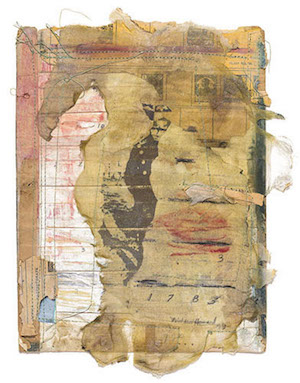Squarecylinder.com has just published a profound piece by Jeff Kelley
on our current exhibition Mildred Howard: Spirit & Matter … it is truly illuminating and you can find it here. The exhibition runs through May 24:
Mildred Howard @ Richmond Art Center
Jeff Kelley, May 9, 2015
Mildred Howard’s quasi-retrospective installation of assemblages, mixed media prints, collages, and sculptures at the Richmond Art Center is elegantly spare and richly reverberant. If you stand at the entrance and squint the show falls softly into place. We intuit this to be an organic whole, an assemblage of assemblages. While the gallery space is not very big, its reputation as a decades-long outpost for noteworthy Northern California art precedes it, adding a buzz to the atmosphere. A few well-positioned red walls incite a modernist semaphore, signaling the era from which Howard’s works emerge. She is a modern artist, of course, but from its wing of conceptual collage, which draws mostly upon photo-and-other-graphic impressions from the not-so-distant past, her family’s. She also draws upon a kind of thrift, hand-me-down, or secondhand material culture for the assembling of her sculptures.
 |
.jpg) |
when it has been lived with, opened and closed, or passed down. Perhaps art can be thought of as formal hand-me-down culture; it’s what artists leave behind for the rest of us, albeit without the sentiment usually associated with personal keepsakes. But Howard’s assemblages, rooted in what might be called African-Americana, draw upon that sentiment as a source of meaning. And yet it feels like an expression of loss.
Howard is trying to hold something together in her works, some moments of recognition, perhaps, when keepsakes become art; when vernacular speech becomes titular and punny; when the given histories of found objects cede to the emergent content of the artist’s process; when family storytelling combusts into modernist black magic; when incongruous juxtapositions of objects and media become easy exchanges of history and memory; when an artwork asserts its aesthetic privilege while remaining open to worldly influence. Seeking moments of recognition in the practice of art is a matter of finding your spirit in the materials at hand. Maybe you’ve handled them before (during childhood, at reunions, in grandma’s house), but not with an artist’s awareness. Aesthetic cognition is always re-cognition, like when you see something familiar as if for the first time. It requires what Harold Rosenberg once called, in reference to post-war action painting, “alert waiting.” Howard has been waiting alertly for decades for the objects in the studio to tell her what to do. She recognizes their metaphoric potential in relation to each other, the way words and images add up to a story. Then she “tells” them.
 |
Safe House (2005) is a ceiling-high outline of a small house whose steel lines are gilded with butter knives placed end-to-end, and whose floor is filled with polished and tarnished silver tableware. At the same time, a host of platters, goblets, and serving trays stream out one end of the house along the wooden gallery floor toward a wall punctured with dozens of cutting knives, as if a vortex was sucking the house’s contents into a blinding white sky. This rapid transition from domestic containment to the projection of rage is unsettling. For generations of African-Americans, safe houses were integral parts of the Underground Railroad, offering sanctuary for slaves escaping bondage in the south. It is in this sense that Howard’s sculpture provides a symbolic place for all the ornate silver serving-ware polished and tarnished by countless black hands.
“My hand is there,” says Howard, referring to a number of sculptures in which her hands are cast in what appear to be gestures of offering, holding, shaping, receiving, and bestowing. In Switchin’ in the Kitchen: From Dakar to Detroit & the Mississippi Delta(2013) bronze castings of the artist’s hands, as if severed from the body, hover above old vinyl records, séance-like, or seeming to rotate the disks back and forth, like a hip-hop DJ. The 78 rpm records Howard uses were once called race records. Beginning in the 1920s they were marketed to African-Americans, although whites bought them, too. By the late 1940s the music became known as rhythm and blues, and changed American society by popularizing music rooted in African-American experiences. From playing the trumpet to mixing vinyl, the bronze hands in Howard’s Switchin’ seem like they are conducting generations of music through their fingertips – and giving off sparks.
Skillet to the Frying Pan: Sitting Black (2001), a wooden four-legged stool with a large, long-handled black skillet sticking up from its seat (a la Duchamp’s bicycle wheel) seems a lightening rod for Howard’s stance as an artist, linking the conceptual and the surreal. Like those in
 |
Duchamp’s iconic “readymade,” Howard’s materials are commonplace. But Skillet is a ready-remade of the 1913 original, a further distortion of that already surreal juxtaposition of a stool and a wheel, looking like an upside-down unicycle. The skillet, black as coal, feels hot to the psyche. And yet it rises skyward, like black sunflower to the sun. Affixed to the pan is a tiny, ornate picture frame, which frames nothing but the blackness of the iron.

